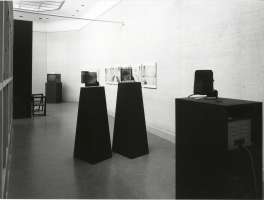Abstract
This article follows Nauman’s practice where he led it in 1968, exposing a more tech-savvy, enterprising streak than is typically acknowledged. The holograms play an underrecognized transitional role in the young artist’s development—a turn away from the “crude fiberglass forms, limp latex and cloth sculptures, and sputtering neon signs” he was then displaying in museums and galleries. The sculptures he exhibited in the mid-1960s had “the appearance of poor craftsmanship,” with a “carelessness” undaunted by its own “total lack of elegance.” Early assessments like these set the tone for nearly all the critical reviews that followed, which tapped a vocabulary of the makeshift, the tossed off and thrown together.
A case study of the holograms is a bid to unsettle this most stubborn narrative of Nauman’s early career: that shoddy production values always resulted in “what looks like accidental art,” or that “negligible effort” went into “rough, scruffy objects, made from the cheapest, most available materials.” Mistaking the artist’s deliberate deskilling for indifference, the Nauman scholarship on this period perpetuates an image of the artist cloistered in his California studio, making art with whatever was close at hand, switching casually from one format to the next. Yet there was nothing casual about tackling holography in the 1960s, and archival records show that Nauman went to real trouble to pursue it. The outreach campaign, research, and travel required—not to mention the considerable expense—invest holography with a greater importance to his oeuvre than it has yet been granted.


